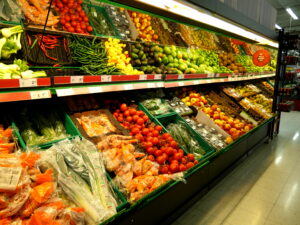Food Waste: $2.4 Trillion Left Rotting in a Heap

The scale of the problem
The scale of the global food waste problem is astonishing. We waste 30% of every calorie that is grown, raised, or cultivated around the world. If food is an $8 trillion industry, then the food waste market being tackled by startups in figure 1 can be valued at $2.4 trillion.
In the U.S. alone, food loss is between 31%-40% of overall food production, meaning Americans waste around $160 billion on food each year. This figure grows to $218 billion when including farming, processing, transportation and disposal. This equates to 1.3% of GDP. Wasted food accounts for around 20% of consumption of fresh water, fertilizer, crop land, and landfill. Food waste is the single largest category of material placed in municipal landfills even while 37.2 million Americans are food insecure. Globally, food insecurity is at 12.9%, or one-in-eight people on earth.
For corporates working in the food industry the responsibility is enormous, but the potential rewards are too. While regulation and sustainability goals are increasingly stringent, the key driver forcing corporates to reduce waste is consumer pressure favoring responsibly sourced products, with traceable provenance, that don’t spoil by the time you are home from the grocer. For the retailer, managing inventory to avoid waste and stocking high quality products with long shelf lives are increasingly seen as a competitive differentiator by customers.

Improving collection and use of data across the food chain to prevent waste
As you can see from the number of participants at each step in the food chain in figure 2, fragmentation in the food supply chain has led to low standardization of data tracking and sharing. This makes typical data analytics-based efficiency plays more difficult in the food industry. Sharing data between supply chain operators is low due to fears of competitive advantage being lost, or because data collection is so poor. As the saying goes, what gets measured gets managed. To combat this lack of usable data, two solutions are being developed.
The first is top-down efforts such as IBM’s Food Trust blockchain solution. IBM’s solution takes vertically integrated supply chains, like those in the companies shown, and connects participants across the food supply through a permissioned, permanent and shared record of food system data. IBM is well placed to provide this service as they can act as the Switzerland of data, removing a supply chain company’s concern of being locked into providing many different sets of data to its various customers and removing concerns about data security from both sides of the transaction.

The second is startup innovation that offers sensors for data collection and data analytics services. Escavox offers a service to help growers, retailers and other supply chain partners manage their supply chain more effectively. Their sensor hardware travels with a product from the harvest stage through the supply chain, giving the customer a window on where temperature fluctuations and dwell times were longest. This increased visibility in the supply chain reduces loss the cost of the product.
Automation to reduce waste
The food chain is automating rapidly at the consumer end but slower upstream. Companies such as Takeoff are automating grocery order fulfillment, while logistics software is optimizing delivery schedules. For the consumer, Instacart exists to provide convenience and hassle-free shopping, although the introduction of an extra step in the supply chain has led some to question whether adding a step in the supply chain is a sustainable business model.
Upstream, things are still looking very analog. As food is one of the last industries to digitize, there is still plenty of pen and paper, phone and fax-based systems in the food chain. Innovation in automating steps in the supply chain like quality inspection (ImpactVision), safety testing (Clear Labs) and many other steps are still at the Series A/B stage. It is essentially still an analog system for logistics efficiency, not for freshness and waste reduction. In reaction to this, companies such as GrubMarket, which has a strong B2B wholesale platform to compliment its B2C platform, is looking to sell a software integration tool for supply chain players to help get product to consumers faster.
Food recovery
Food recovery was, for a long time, the preserve of non-profits and charitable organizations. No longer. In a recent Cleantech Group Power Breakfast, Aleks Strub, the CMO of Imperfect Foods, gave the example of a salmon farmer from Norway. The farmer supplied many retailers across the globe with 4oz. salmon fillets. However, because salmon do not grow in perfect 4oz. fillets, the supplier had many 3oz. and 5oz. fillets going to waste. Imperfect Foods can bundle these into 1lb packets and sell for $9.50/lb, where the 4oz. fillets in the supermarket may cost you two or three times that.
Food recovery businesses are thriving due to logistics improvements and business model innovation. While Imperfect have gone after the D2C market, acquiring customers is expensive and difficult. It also requires them to own an expensive delivery system in order to control the interaction with its customers. Other companies, such as Full Harvest, are focusing on B2B in order to avoid the operations cost of a consumer-facing business while still ensuring imperfect produce is incorporated in the food chain.
SDG12.3 and the rise of regulation
Issued by the United Nations General Assembly, Sustainable Development Goal 12.3 reads:
‘By 2030, halve per capita global food waste at the retail and consumer levels and reduce food losses along production and supply chains, including post-harvest losses.’
Increasingly governments are taking action. The Champions 12.3 2019 progress report claimed that Countries representing just 15% of the world’s population are acting at scale to reduce food loss and waste. No country has yet announced a halving of food loss and waste, with a lack of quantification at the national level hindering tracking of this milestone. The report also claims that one-third of the world’s 50 largest food companies have established food loss and waste reduction programs to accelerate action, while two-thirds have set targets that align with SDG 12.3.
Corporates are stepping up
In response to SDG12.3 and the trend towards regulation on food waste, corporates are engaging with innovation and reducing food waste in a few ways. Some examples include:
- Kroger’s ‘Zero Hunger – Zero Waste’ campaign has set up a $10 million innovation fund through the Kroger Foundation and is expanding its activity in the space through a partnership with ReFED. The company has taken 100 million pounds of food out of the company’s waste stream in 2018, a 40% reduction year-on-year. The program has found that tracking waste is the most challenging aspect. This is not due to the lack of technology available to track waste but due to the human element of having a half-million workforce all needing re-training on how to help prevent waste.
- General Mills has focused more on food recovery solutions, awarding over $1 million to organizations in the US to help reduce hunger and food insecurity.
- Sysco has committed to divert 90 percent of operations and food waste from landfills by 2025.
- The Chobani accelerator program lists this key challenge for potential applicants: In what ways can we innovate ingredients, formulations and packaging materials to increase shelf life and reduce food waste?
- Walmart has extended its zero waste goals to include the whole supply chain, from farming and manufacturing, consumption to end of life.
Keep an eye on…demand prediction
The bullwhip effect theorizes that if information is not accurate or up to date when it’s sent through a supply chain, then a change of ± 5% in actual consumer demand can result in companies further back in the chain thinking it’s ±40%. In the food industry, this can lead to over-production, over-supply, and waste. Couple this with food brands’ fear of under-supplying retailers with a hit product, and over-production is inevitable. Accurate demand prediction combined with improved inventory management are key to ensuring the right amount of food goes to the right place. A number of innovators are looking at this problem.
- Crisp is a demand forecasting tool to optimize food production systems, backed by FirstMark Capital, Spring Capital, Swell, and HDM. While Crisp’s platform isn’t widely available yet, it plans to generate granular demand forecasts will improve difficult parts of the food system from production planning through to use-by dates.
- Tastewise is a developer of software that can predict food trends. While the tool is targeted at large food and beverage corporates looking to create products that match changing food trends, the tool can also divert production of unpopular products and improve production planning.
- AIPalette works in a similar way to Tastewise. It uses deep learning and big data analytics to address the challenges in the different stages of food product innovation. This includes a ‘foresight engine’ to spot trends, but also a validation process to decide which product is best fit for a coming consumer trend.
- TotalCtrl helps retailers optimize their inventory and improve this competitive advantage from in-store data unavailable to online-only providers.


